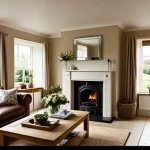The Shift from Traditional to Minimalist Home Aesthetics
Minimalism in UK homes marks a significant departure from traditional British decor, which often celebrates intricate patterns, heavy furnishings, and ornate detailing. This evolution in interior design emphasizes clean lines, open spaces, and a restrained color palette, creating a sense of calm and clarity.
Key visual changes include replacing cluttered rooms with uncluttered, airy environments. Structural adjustments often involve removing unnecessary partitions to improve flow and maximize natural light—features not traditionally prioritized in classic British interiors. The shift reflects broader cultural drivers such as increased urban living, a desire for sustainability, and the psychological appeal of simplicity in hectic modern lives.
This might interest you : How is the UK handling the integration of technology in public services?
Adopting minimalism in UK homes means balancing the heritage charm of traditional properties with functional, streamlined aesthetics. This balance enables homeowners to enjoy both historical character and contemporary comfort. Overall, the move towards minimalism offers a refreshing contrast to conventional British home decor while responding to changing lifestyle needs and values.
The Shift from Traditional to Minimalist Home Aesthetics
Minimalism in UK homes represents a clear break from traditional British decor, which often features heavy furnishings and intricate patterns. While traditional British decor embraces ornate details, minimalism in UK homes strips interiors down to essentials, focusing on clean lines and open, airy spaces. This interior design evolution prioritizes natural light and decluttered layouts, avoiding the visual complexity common in classic British homes.
Also to see : How is the UK Real Estate Market Impacted by Financial Regulations?
Key visual and structural changes include removing excessive partitions and replacing bulky furniture with sleek, functional pieces. Minimalism in UK homes encourages a restrained color palette, often neutral tones, which contrasts with the richer, darker colors seen in traditional British decor. This approach enhances the feeling of spaciousness, even in smaller rooms typical of older UK properties.
Cultural drivers behind adopting minimalism in UK homes include growing urbanisation, environmental concerns, and a desire for mental clarity amid busy lifestyles. These factors fuel the interior design evolution, appealing to those who want to blend the comfort of heritage properties with simplicity and functionality.
Adapting Minimalism to UK Architectural Features
Adapting minimalism to the diverse UK housing styles involves thoughtful integration of pared-down aesthetics within the constraints of period homes like Victorian, Georgian, and Edwardian properties. These homes often possess ornate mouldings, high ceilings, and classic fireplaces that define their character, making a total redesign challenging. Successful minimalist transformations maintain these heritage elements while introducing functional design that prioritises simplicity and usability.
Balancing heritage character with minimalism means selecting furniture and colours that complement original architectural details without overwhelming them. For example, sleek, neutral-toned furnishings can highlight intricate cornices rather than compete with them. In many Victorian homes, open-plan living has been achieved by removing non-structural walls to create a lighter, more spacious feel.
Real-life examples demonstrate minimalist adaptations enhancing period homes’ usability without erasing history. A Georgian flat might retain its original sash windows and wood flooring but introduce minimalist shelving and clean-lined lighting, preserving charm while providing contemporary comfort. This approach allows homeowners to enjoy the best of both worlds—historical authenticity melded with the clarity and calm of minimalism.
Enhancing Space and Functionality Through Minimalist Design
Minimalism in UK homes significantly improves space utilization, especially in older properties where rooms can be small or irregularly shaped. By prioritising decluttering, homeowners create open, flexible areas that make efficient living possible without sacrificing comfort. Decluttering involves removing unnecessary items, organising essentials with purpose, and choosing storage solutions that blend seamlessly with the home’s aesthetics.
Essential minimalist furniture plays a key role. Pieces often serve multiple functions, such as storage ottomans or fold-away tables, maximising utility while maintaining clean lines. This approach directly addresses spatial constraints typical of traditional British decor, which historically favored bulky furnishings.
Layout choices are equally important. Arranging furniture to allow easy movement and maximise natural light helps enhance the sense of space. For example, positioning seating away from walls to open up flow or using transparent materials such as glass can visually expand rooms.
Together, these strategies transform UK homes. They enable homeowners to enjoy uncluttered environments that maximise every square foot, offering practical solutions to long-standing issues while supporting the minimalist lifestyle.
The Lifestyle Impact of Minimalism in UK Households
Minimalism in UK homes profoundly reshapes everyday life and wellbeing for many families. By simplifying possessions and prioritising functional design, a minimalist lifestyle encourages mindful consumption and reduces the stress of cluttered living environments. Homeowners often report improved mental clarity and emotional calm, as minimalism fosters spaces free from distraction.
How does this shift affect daily habits? Families tend to adopt routines focused on maintenance of openness—regular decluttering, careful purchasing decisions, and intentional organisation. This supports sustainable living by reducing waste and promoting longer product use, aligning with increasing environmental awareness in UK households.
The psychological benefits are linked to both the physical space and the mindset minimalism cultivates. Clear, airy rooms reduce feelings of overwhelm, while the practice of thoughtful living nurtures satisfaction and contentment. Minimalism thus goes beyond aesthetics, influencing behaviour and wellbeing positively.
Ultimately, embracing minimalism in UK homes offers a holistic approach to lifestyle that supports emotional health, sustainability, and a more purposeful daily existence, aligning closely with contemporary values and family needs.



